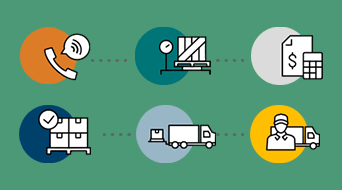Utilizing Supply Chain Technology for Customer Loyalty During Disruption
Any small to midsized business (SMB) that has been shipping over the past few years knows that supply chain disruption will occur at some point. There’s nothing that can be done to prevent these events and the ripples they create in shipping operations.
But by utilizing the proper supply chain technology and understanding how to handle supply chain disruptions, shippers can protect their bottom line. They can also manage their brand image and keep customers loyal to their company — even during turbulent times.
Impact of Supply Chain Disruption on SMBs
It’s important to understand some critical data that shows how supply chain disruptions disproportionately affect SMBs. These shippers have fewer resources and smaller budgets compared to their larger counterparts. Their biggest challenge, however, could be their lack of technological advancements and capabilities that make shipping more efficient.
This creates an uneven playing field in the marketplace and makes times of disruption even more unmanageable. A recent SMB Retail Supply Chain Survey by Software Advice claims that:
“No one is immune to the ongoing disruptions, but larger companies tend to place larger orders and essentially are less risky for suppliers than small businesses — 91% of SMB retailers feel that larger companies have an advantage over them in their ability to procure inventory.”
The research also found that among SMBs, “46% have had at least one vendor drop them for reasons specifically related to being a small business,” and another “23% are expecting to be dropped in the near future.”
As a shipper, the data proves what you already know or assume: SMBs must find effective strategies and implement innovative technology to manage customer expectations along with inventory levels — particularly during times of supply chain disruptions.
Supply Chain and Customer Satisfaction: Buyers are (Somewhat) Patient
Luckily for SMBs, many customers are sympathetic in times of supply chain disruption. According to research by Mitto, a provider of global communications solutions, keeping customers informed about the status of their deliveries makes a difference in how they perceive your brand. The study found:
- “93% of Americans are more likely to have patience around delivery delays with a brand they already associate with good customer service.”
- “91% of respondents said that a good customer experience makes waiting for a product bearable.”
Frankly, those numbers are staggering. They indicate that more than nine in 10 customers — a vast majority — are willing to remain loyal to a brand if they provide great customer service while they are waiting for their late or lost shipment.
So, while you can’t prevent supply chain disruption, you can invest in processes that make the customer experience “bearable” during the times when you, as an SMB, have less control over vendors and procurement. As you might have guessed, supply chain technology, including a transportation management system, is key to keeping customers informed and patient.
Retaining Your Customers at All Costs
The reasons to keep customers happy during supply chain disruptions are relatively obvious. They are the same reasons to keep customers happy all the time. But supply chain disruption creates risk. Shipments are increasingly late, missing or potentially damaged during these times and customer experience should be elevated since the chances of losing a customer increases.
That’s why shippers need to be super diligent during disruption. After all, it is well documented that acquiring new customers is much more costly and time-consuming than keeping those who already do business with you. As reported by Outbound Engine, a marketing company:
- “Acquiring a new customer can cost five times more than retaining an existing customer.”
- “Increasing customer retention by 5% can increase profits from 25-95%.”
- “The success rate of selling to a customer you already have is 60-70%, while the success rate of selling to a new customer is 5-20%.”
Most shippers have probably come to these conclusions on their own. And if so, the question must be asked: what are you doing and how is your technology helping retain your customers during supply chain disruptions?
Connecting the dots. What does all the supply chain disruption data mean?
In short, research tells us that SMBs feel outmatched by larger competitors during disruption. However, customers are sympathetic to those companies that are willing to effectively communicate with them during these times. SMBs should take note of these findings because acquiring new customers is much more taxing than keeping your current ones.
Bingo! Check, please!
Not so fast. A stumbling block for many SMBs is understanding how to implement strategies to maintain customer satisfaction during supply chain disruption. Unishippers believes much of this relies on supply chain technology.
Utilizing Technology in Supply Chain Processes
During inclement weather, labor disputes, pandemics and other times of disruption, customers still expect to understand the status of their shipments. That is the common denominator for anyone who orders a product that is shipped.
If the shipper cannot provide those details, customer satisfaction will sway, and your brand will suffer. But by utilizing the following supply chain and logistics technology platforms, shippers can control inventory, keep customers informed about the status of their shipments and retain their business.
- TMS supply chain platforms — A transportation management system (TMS) allows you to easily compare costs and delivery options within one platform — which means no more time-consuming rate checking. Plus, a TMS allows you to track all your shipments in one place, as well as keep all your orders, invoices and other files organized and searchable. This creates processes that you can quickly leverage to determine the status of customer shipments.
- E-commerce integrations — By integrating your shopping cart, e-commerce shipping software and TMS, you can limit manual errors and increase supply chain visibility. E-commerce integrations can also streamline your customers’ online experience. This includes leveraging plugins that display up-to-date shipping rates directly in the shopping cart at check-out; allow shippers to easily create shipping labels for hassle-free returns; and — you guessed it — provide updates on the status of shipments.
- Supply chain tracking technology — By adopting technologies to improve your supply chain tracking, your company can purchase and house inventory more efficiently and pivot much more quickly when there are unexpected changes in the shipping industry. Through machine learning software, algorithms can automatically adjust and optimize stocking strategies, demand plans and inventory. This creates an environment where you can properly manage inventory and understand exactly what needs to be communicated to the customer.
Unishippers Is an Industry Leader In Supply Chain Technology Solutions
Implementing strategic supply chain technology is imperative for shippers who value customer satisfaction and want to understand how to handle supply chain disruptions and other shipping challenges. Unishippers can implement changes to your supply chain and logistics technology to create surefire ways to enhance your company’s efficiency, reputation, processes and bottom line. We also provide a full suite of industry-leading parcel, freight and specialty shipping options that thousands of shippers across the nation utilize on a daily basis.
Contact Unishippers to learn how our innovative technology minimizes the impact of supply chain disruption on your business and improves customer satisfaction in supply chain processes. Reach out for a free consultation today and speak to an expert.


